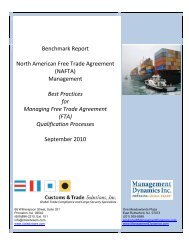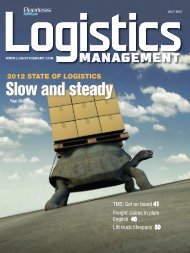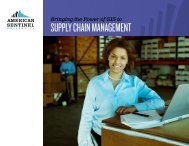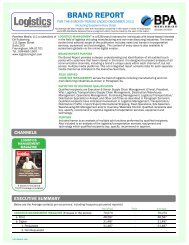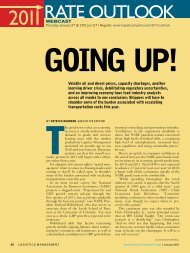Logistics Management - June 2010
Logistics Management - June 2010
Logistics Management - June 2010
You also want an ePaper? Increase the reach of your titles
YUMPU automatically turns print PDFs into web optimized ePapers that Google loves.
Peak Oil, continued<br />
time addressing the real problem—how<br />
to optimize overall transportation and<br />
reduce fuel consumption. I propose that<br />
shippers and carriers stop the bickering<br />
and join forces to work collaboratively.<br />
Fuel surcharges first became a hot<br />
topic in the transportation industry in<br />
the mid-1970s, when the U.S. Department<br />
of Energy (DOE) created the<br />
National Retail Average to compensate<br />
carriers for the volatile fuel prices<br />
of the OPEC oil crisis era. It operates<br />
the same way today as it did back then:<br />
Each Monday, a representative group<br />
of approximately 350 retail diesel outlets,<br />
including truck stops and service<br />
stations, report their retail diesel prices.<br />
The DOE then uses that data to issue<br />
the national average diesel price for<br />
that week.<br />
This process became, by default, the<br />
baseline for the weekly fuel surcharge<br />
rates billed by the carrier. Today, fuel<br />
charges change on a weekly basis with<br />
most LTL carriers, and can vary as<br />
much as 25 percent from carrier to carrier.<br />
Under this scenario, if fuel prices<br />
increase during the week, the shipper<br />
wins and the carrier loses. If fuel prices<br />
fall during the week, the carrier wins<br />
and the shipper is the loser.<br />
Fuel surcharges are calculated as a<br />
percentage of the shipment charges<br />
expressed as a percentage of the total<br />
shipment cost. As I write this article it<br />
just so happens to be in the 22 percent<br />
range. The less your shipment charge,<br />
the less the fuel cost portion. The<br />
higher your freight class, the higher the<br />
cost per shipment and the more you<br />
pay for fuel as determined as a percentage<br />
of the shipment cost.<br />
Couple this with using conventional<br />
rate classification approaches and pricing<br />
freight gets even more polluted.<br />
Today there are 18 rate<br />
classifications ranging<br />
from a low of class 50 with<br />
a cost per hundred pounds<br />
of $63.71 to a high of class<br />
500 with a cost per hundred<br />
pounds of $525.66<br />
with no discounts. Your<br />
class of freight and your<br />
freight all kinds (FAK)<br />
range can reduce you total<br />
spend.<br />
Let’s look at an example<br />
of how this works. If<br />
you have multiple freights classes, say<br />
class 50, 70, and Class 100, some carriers<br />
will give you a FAK Class 50. If<br />
you have a Class 100 shipment the cost<br />
would be $239.88 with a fuel cost of<br />
$52.77 for a total of $292.65.<br />
Using the same carrier with a FAK<br />
50, the shipment would cost $138.57<br />
with a fuel cost of $30.49 and a total<br />
cost $169.06. You could also see a 25<br />
percent reduction of the fuel that some<br />
carriers offer. To make matter worse,<br />
carriers toss in discounts of up to 90<br />
percent.<br />
This is a great example that shows<br />
that conventional approaches to pricing<br />
freight is analogous to a playing a<br />
shell game; sometimes things appear<br />
and sometimes they don’t. Depending<br />
on how shippers and carriers play the<br />
game, there is a winner and a loser.<br />
This approach is myopic and inefficient<br />
and encourages discontent, finger<br />
pointing, and distrust between shippers<br />
and carriers.<br />
Optimize transPOrtation,<br />
reduce fuel<br />
The transportation community<br />
should instead work together to figure<br />
out how to optimize transportation<br />
and reduce the amount of fuel used.<br />
Perhaps it’s time that all organizations<br />
involved in the LTL mix explored a better<br />
way of working together and tied it<br />
to a national goal to reduce fuel consumption.<br />
I love the concept of “vested outsourcing”<br />
that Kate Vitasek and her colleagues<br />
at the University of Tennessee<br />
are teaching. Using vested principles,<br />
shippers and carriers work together to<br />
find better ways to decrease fuel consumption.<br />
The concept espouses transparency<br />
and fairness, and the<br />
transportation community<br />
should rise to<br />
the occasion to work<br />
together to optimize<br />
transportation and quit<br />
playing a shell game<br />
and bickering over fuel<br />
service charges and<br />
rate discounts where<br />
the company with the<br />
most muscle or political<br />
clout wins.<br />
For example, Wal-<br />
Mart and UPS have started programs<br />
to reduce carbon footprints. These<br />
programs track the credits you can use<br />
and help provide visibility that should<br />
help reduce carbon and use less fuel.<br />
I particularly like the lead that Wal-<br />
Mart has taken in this area to focus on<br />
packaging.<br />
Wal-Mart wants its 60,000 suppliers<br />
to cut the amount of product packaging<br />
they use throughout the supply chain<br />
by 5 percent starting in 2008, saving<br />
the world’s largest retailer $3.4 billion<br />
in the process. Wal-Mart’s five-year<br />
plan will monitor suppliers and recognize<br />
those who use less packaging, better<br />
materials and more efficient sourcing<br />
for the packaging they use. The<br />
company estimates its move will cut<br />
nearly $11 billion in supply chain costs<br />
and prevent more than 660,000 tons of<br />
carbon dioxide being released into the<br />
atmosphere.<br />
The example above tells how reducing<br />
packaging 5 percent saved the<br />
money due to better load averages and<br />
more freight per trailer, allowing the<br />
carrier to use the equipment more efficiently.<br />
If shippers realize that LTL pricing is<br />
based on density and value, then each<br />
pound per cubic foot reduction saved<br />
will allow for better carrier pricing and<br />
greater load factor—and they can use<br />
this better efficiency to help obtain better<br />
rates.<br />
It all adds up: Same trailer, more<br />
shipments per trailer, better fuel cost<br />
per SKU. Now, what if Wal-Mart would<br />
take some of those savings and share<br />
it back with the suppliers and carriers<br />
who helped them optimize their transportation<br />
M<br />
—Derik Andreoli, Ph.C., is co-founder<br />
of the energy think tank Energy Transitions<br />
Northwest and faculty affiliate of the<br />
Harvard Business School Microeconomics<br />
of Competitiveness Program. He can be<br />
reached at derikandreoli@gmail.com.<br />
—Hank Mullen is President of The<br />
Visibility Group and Freight Pricing<br />
Experts, a specialized consulting firm<br />
that seeks to use space occupied pricing<br />
to drive transparency and visibility to<br />
help companies optimize their transportation<br />
efforts. He can be contatacted at<br />
hmullen@thevisibilitygroup.com.<br />
32 <strong>Logistics</strong> <strong>Management</strong> WWW.LOGISTICSMGMT.COM | <strong>June</strong> <strong>2010</strong>




